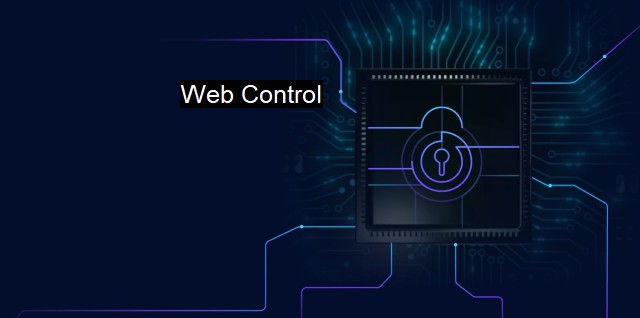What is Web Control?
Web Control: Boosting Cybersecurity in a Digital Landscape
Web Control in the context of cybersecurity namely refers to internet security software's capability to control, filter, restrict, and monitor internet use. With cyber threats pervading the online environment today, the need for effective methods to mitigate online risks is more pressing than ever, hence the importance of Web Control.Web Control provides comprehensive solutions meant to protect online users from malicious websites, potentially dangerous files, and phishing attempts. One primary feature of Web Control is URL filtering. This mechanism blocks the loading of risky or inappropriate websites based on predefined categories or lists. Businesses, educational institutions, and individuals use this tool to hinder access to potentially dangerous elements.
To understand the function of Web Control more deeply, imagine the digital world as a physical city. In an actual city, safety measures include traffic controls, speed limits, law enforcement, security personnel, safety guidelines, and other protocols to maintain peace and order. In the digital city where virtually all enterprises operate today, cyber threats equate to the city's potential dangers - hacked accounts, financial fraud, identity theft, corporate espionage, and others. In this scenario, Web Control serves as the sophisticated "cybersecurity traffic system" that regulates and controls digital activities to maintain safety and order.
Web Control technologies offer real-time protection, which is crucial in the fast-paced setting of the digital landscape. Given that threats can instantly strike at any given time, persistent monitoring is essential. Such technology can quickly detect suspicious activities, allow or disallow access to specific websites, and prevent malicious downloads.
It is worth noting that the online risk environment includes not just apparent threats like fraud and breaches, but also areas linked to productivity. For instance, employers may want to exempt specific sites from their workers' access as they tend to engage in time-wasting activities, hence increasing productivity losses. Schools might also employ strict internet use controls to promote a cyber-safe and study-focused online environment. With its website categorization function, Web Control plays a significant role in propelling productivity and supporting policies in various contexts.
There's also the largely under-appreciated benefit of Web Control that particularly concerns data protection. Web Control solutions can prevent data leakage - intentional or accidental - by controlling uploads and access to sensitive sites that may compromise confidential data.
For wide-ranging, personalized cybersecurity measures, Web Control commonly integrates with antivirus software. Antiviruses generally protect a computer from a host of malicious agents - macroviruses, trojans, ransomware, and other threats. Integrating Web Control to antivirus software includes adding another layer of protection. As the digital environment becomes increasingly intricate, having an antivirus that only guards against viruses has become insufficient. Hence, many have shifted towards an all-encompassing tech protection approach.
Adding Web Control functions to antivirus broadens the software's guarding capabilities. Instead of merely waiting for the threat to infiltrate the computer system, Web Control technologies proactively screen the web environment for threats, thereby inhibiting these from being downloaded. as the threats evolve, Web Control also scales adaptively through frequent updates.
Implementing Web Control as feature sets in cybersecurity frameworks presents a formidable defense against cybercrime. It blocks harmful elements even before they reach devices, thereby minimizing consequences such as disruptions or performance degradation.
Web Control is an essential tool in the practice of cybersecurity. It serves as a watchful eye over the expanses of the digital city, protecting users from threats, enforcing policies, maintaining order, and preserving productivity across the digital landscape. Through Web Control, digital environments are made safer, harnessing the full benefits of the internet while mitigating potential dangers.

Web Control FAQs
What is web control in cybersecurity and antivirus?
Web control refers to the ability of antivirus software and other security tools to block access to potentially harmful websites or limit access to certain types of websites. This feature is designed to prevent users from inadvertently downloading malware or visiting sites that could compromise their security.How does web control work?
Web control typically relies on a combination of techniques to block or limit access to websites. This may include blacklisting known malicious sites, using URL filtering to block sites based on their content or category, or employing reputation-based systems that analyze sites for warning signs of threats.Why is web control important in cybersecurity?
Web control is an important feature of cybersecurity because many cyber threats are delivered through the web, either through malicious downloads or by tricking users into visiting dangerous sites. By blocking access to these sites or warning users when they attempt to visit them, web control can help prevent cyberattacks and keep systems and data safe.Can web control be customized?
Yes, many antivirus and security tools allow users to customize their web control settings. This may include whitelisting certain sites to allow access, setting different levels of blocking or warning for different categories of sites, or adjusting settings for different users or groups within an organization.| | A | | | B | | | C | | | D | | | E | | | F | | | G | | | H | | | I | | | J | | | K | | | L | | | M | |
| | N | | | O | | | P | | | Q | | | R | | | S | | | T | | | U | | | V | | | W | | | X | | | Y | | | Z | |
| | 1 | | | 2 | | | 3 | | | 4 | | | 7 | | | 8 | | |||||||